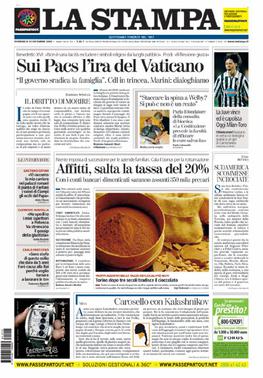La Stampa (English: "The Press") is an Italian daily newspaper published in Turin with an average circulation of 87,143 copies in May 2023.[1] Distributed in Italy and other European nations, it is one of the oldest newspapers in Italy.[2] Until the late 1970s and early 1980s, when the country underwent a nationalization process, La Stampa and Corriere della Sera were not real national daily newspapers, as their geographical area of circulation was mostly limited to Piedmont for La Stampa and Lombardy for Corriere della Sera; thus, both papers shared a readership that was linked to its place of residence and its social class, mostly from the industrialist class and financial circles.[3] La Stampa has "historically" been Turin's newspaper of record.[4] It is considered one of Italy's leading national newspapers alongside Corriere della Sera, la Repubblica, Il Sole 24 Ore, and Il Messaggero.[5]
 Front page, 10 December 2006 | |
| Type | Daily newspaper |
|---|---|
| Format | Berliner |
| Owner(s) | GEDI Gruppo Editoriale |
| Publisher | GEDI Gruppo Editoriale |
| Editor | Andrea Malaguti |
| Founded | 1 February 1867 |
| Political alignment | Social liberalism Progressivism Formerly: Fascism (1925–1945) Anti-communism |
| Language | Italian |
| Headquarters | Via Marenco 32, Turin, Italy |
| Circulation | 256,203 (2012) |
| Sister newspapers | la Repubblica (since 2017) |
| ISSN | 1122-1763 |
| Website | www |
History and profile
The paper was founded by Vittorio Bersezio, a journalist and novelist, in February 1867,[2][6] with the name Gazzetta Piemontese.[7] In 1895, the newspaper was bought and by then edited by Alfredo Frassati (father of Pier Giorgio Frassati), who gave it its current name and a national perspective.[7] For criticizing the 1924 murder of the socialist Giacomo Matteotti, he was forced to resign and sell the newspaper to Giovanni Agnelli.[7] The financier Riccardo Gualino also took a share.[8] The paper is now owned by GEDI Gruppo Editoriale,[9] and has a centrist stance.[10] The former contributors of La Stampa include Italian novelist Alberto Moravia.[11] In 2004, Angelo Agostini categorized La Stampa as an institution daily (quotidiano-istituzione), alongside Corriere della Sera, in contrast to the agenda daily (quotidiano-agenda) like la Repubblica, and the activist daily (quotidiano-attivista) like Il Foglio, Libero, and l'Unità.[12]
La Stampa, based in Turin,[13] was published in broadsheet format,[14] until November 2006, when the paper began to be published in the Berliner format.[15][16][17] It launched a website in 1999.[6] La Stampa also launched a project, called Vatican Insider, run by the daily newspaper and has among its staff several Vatican affairs analysts.[18] Since 26 May 2006, it has published the monthly magazine Specchio+. From 26 January 1996 to 7 April 2006, it was called Specchio, which was published as a weekly supplement, a general interest magazine.[19] In September 2012, La Stampa moved to its new headquarters in Turin, leaving its historical editorial building.[6] Mario Calabresi was the editor-in-chief of the daily.[20][21][22]
On 9 April 2013, an explosive device was sent by an insurrectionary anarchist group, the Informal Anarchist Federation, to the offices of La Stampa;[23] it did not detonate.[23] In June 2017, during the celebration for its 150 years of activity, La Stampa hosted the international conference "The Future of Newspaper", where many great actors of the news industry discussed about the future prospects for the news agencies. Among them John Elkann (editor of La Stampa), Jeff Bezos from The Washington Post, Louis Dreyfus CEO of Le Monde, and Mark Thompson CEO of The New York Times.[24] In April 2020, Maurizio Molinari was appointed as new editor of la Repubblica and was replaced by Massimo Giannini (former journalist of la Repubblica and Radio Capital). Under his guide, La Stampa moved to a more marked centre-left position.[25]
Circulation
The 1988 circulation of La Stampa was 560,000 copies.[9] In 1997, the paper had a circulation of 376,493 copies.[13] Its circulation was 399,000 copies in 2000,[26] and 409,000 copies in 2001.[14] The circulation of the paper was 330,000 copies in 2003,[10] and 345,060 copies in 2004.[27] Its 2007 circulation was 314,000 copies.[28] In 2012, the circulation of the paper was 256,203 copies.[29]
Contributors
Editors
- Massimo Giannini (editor)
- Massimo Gramellini (vice-editor)
- Roberto Bellato (vice-editor)
- Umberto La Rocca (vice-editor)
- Federico Geremicca (vice-editor, Rome)
Columnists and journalists
- Massimo Gramellini (columnist)
- Barbara Spinelli (columnist)
- Mario Deaglio (columnist)
- Lucia Annunziata (columnist)
- Guido Ceronetti (columnist)
- Mina (columnist)
- Maurizio Molinari (journalist)
- Stefania Miretti (columnist)
- Roberto Beccantini (columnist)
- Altiero Scicchitano (columnist)
- Fiamma Nirenstein (columnist)
Former journalists
See also
References
Further reading
- Merrill, John C.; Fisher, Harold A. (1980). The World's Great Dailies: Profiles of Fifty Newspapers. pp. 104–110.
External links

- Official website
 (in Italian)
(in Italian) - Radio Nostalgia — La Stampa-owned local radio station (in Italian)
- Archivio La Stampa — historical archives of La Stampa] (in Italian)
- La Stampa Sportiva — paper archive

